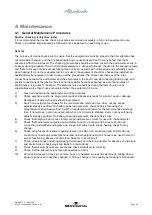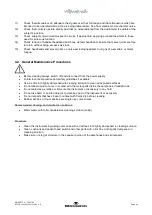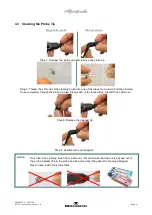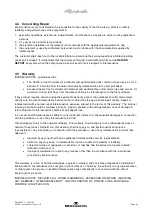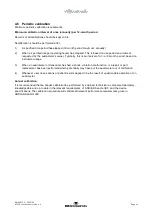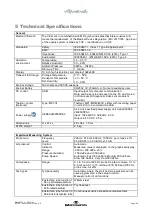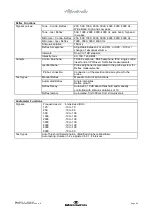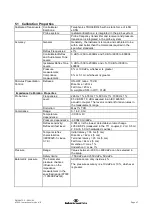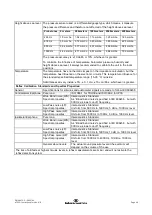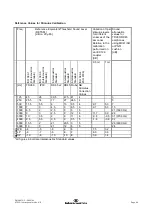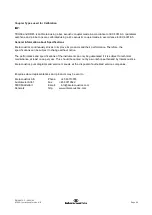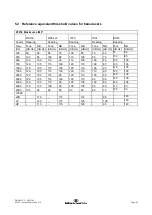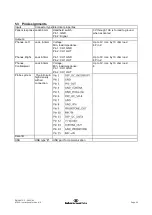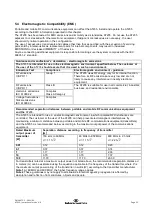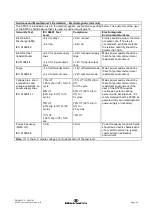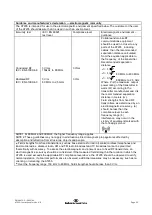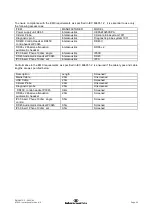
D-0128073-C – 2022/05
AT235 - Instructions for Use - US
Page 53
5.4 Electromagnetic Compatibility (EMC)
Portable and mobile RF communications equipment can affect the AT235. Install and operate the AT235
according to the EMC information presented in this chapter.
The AT235
has been tested for EMC emissions and immunity as a standalone AT235. Do not use the AT235
adjacent to or stacked with other electronic equipment. If adjacent or stacked use is necessary, the user
should verify normal operation in the configuration.
The use of accessories, transducers and cables other than those specified, with the exception of servicing
parts sold by Interacoustics as replacement parts for internal components, may result in increased
EMISSIONS or decreased IMMUNITY of the device.
Anyone connecting additional equipment is responsible for making sure the system complies with the IEC
60601-1-2 standard.
Guidance and manufacturer’s declaration - electromagnetic emissions
The
AT235
is intended for use in the electromagnetic environment specified below. The customer or
the user of the
AT235
should assure that it is used in such an environment.
Emissions Test
Compliance
Electromagnetic environment - guidance
RF emissions
CISPR 11
Group 1
The AT235
uses RF energy only for its internal function.
Therefore, its RF emissions are very low and are not
likely to cause any interference in nearby electronic
equipment.
RF emissions
CISPR 11
Class B
The AT235
is suitable for use in all commercial, industrial,
business, and residential environments.
Harmonic emissions
IEC 61000-3-2
Complies
Class A Category
Voltage fluctuations /
flicker emissions
IEC 61000-3-3
Complies
Recommended separation distances between portable and mobile RF communications equipment
and the
AT235
.
The AT235 is intended for use in an electromagnetic environment in which radiated RF disturbances are
controlled. The customer or the user of the AT235
can help prevent electromagnetic interferences by
maintaining a minimum distance between portable and mobile RF communications equipment (transmitters)
and the AT235
as recommended below, according to the maximum output power of the communications
equipment.
Rated Maximum
output power of
transmitter
[W]
Separation distance according to frequency of transmitter
[m]
150 kHz to 80 MHz
d
= 1.17
√𝑃𝑃
80 MHz to 800 MHz
d
= 1.17
√𝑃𝑃
800 MHz to 2.5 GHz
d
= 2.23
√𝑃𝑃
0.01
0.12
0.12
0.23
0.1
0.37
0.37
0.74
1
1.17
1.17
2.33
10
3.70
3.70
7.37
100
11.70
11.70
23.30
For transmitters rated at a maximum output power not listed above, the recommended separation distance
d
in meters (m) can be estimated using the equation applicable to the frequency of the transmitter, where
P
is
the maximum output power rating of the transmitter in watts (W) according to the transmitter manufacturer.
Note 1
At 80 MHz and 800 MHZ, the higher frequency range applies.
Note 2
These guidelines may not apply to all situations. Electromagnetic propagation is affected by
absorption and reflection from structures, objects and people.
Summary of Contents for AT235
Page 1: ...Instructions for Use US AT235 Science made smarter D 0128073 C 2022 05 ...
Page 2: ......
Page 8: ...D 0128073 C 2022 05 AT235 Instructions for Use US Page 4 ...
Page 18: ...D 0128073 C 2022 05 AT235 Instructions for Use US Page 14 ...
Page 42: ...D 0128073 C 2022 05 AT235 Instructions for Use US Page 38 ...
Page 48: ...D 0128073 C 2022 05 AT235 Instructions for Use US Page 44 ...

